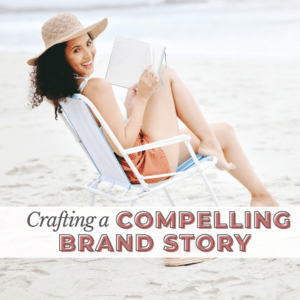With so much content posted to social media every week, you always want to ensure yours stands out above the crowd. One of the most effective ways to accomplish this is to incorporate storytelling into your social media copy. Keep reading to learn more about the power of storytelling for your brand.
But, What is Storytelling?
As someone who spent over 13 years in the vacation rental industry and another three years in a senior healthcare community setting, I have seen firsthand the power of storytelling in marketing and what a difference it can make.
Let’s look at a few examples of how you can weave a story into your social media copy to boost interest and engagement with your followers.
A Vacation Rental Owner Talking About Their Property’s View
Version 1: This property has an oceanfront deck with two chairs and unobstructed views.
Version 2: You and your husband will love enjoying the sunrise while drinking your morning coffee from our oceanfront deck while watching dolphins follow the shrimp boats on their way out to sea.
A Senior Care Community Talking About Their Rehab Services
Version 1: Our in-house therapy department treats patients needing physical, occupational, or speech therapy services.
Version 2: Check out this video of Carol working on her strength and balance as she recovers from hip surgery during her recent physical therapy session in our facility. Carol says her favorite thing about living here while she recovers is that everything she needs is under one roof, and she loves the social aspect of enjoying meals and activities with other patients.
Example #3: A Small Business Owner Talking About The History of Their Business
Version 1: I launched my business in 2019 and help my clients with social media, email marketing, blogging, and more.
Version 2: I’ve always loved a good story. When I was in 2nd grade, I remember staying in from recess for several days in a row to finish a book report. I just kept writing and writing and writing that thing, until one day my teacher finally told me that I needed to go outside and play with my friends. That passion has stayed with me throughout my career, and since 2019 when I launched my business I have been helping my clients create content for their online marketing plans. (Check out this Instagram post for the full story I told about this.)
Do you see the difference? Which version of each of these makes you want to buy? Version 2, right? THAT is the power of storytelling!
Understanding Your Brand Story
You can create a captivating brand story and use it to connect with your target audience as part of your marketing plan. Your brand story is the narrative that communicates your brand’s identity, values, and purpose. It is the story of how your brand came to be, the challenges you have faced, how you overcame them, why you love what you do, and more. A well-executed brand story will help differentiate your brand from your competitors and create a firm emotional connection with your target audience.
Here are the key elements that make up a compelling brand story. It should:
- Be authentic and reflective of your brand’s values and mission.
- Be emotionally resonant and engage your audience on a deeper level.
- Be relevant to your target audience and demonstrate how your brand delivers value to them.
- Differentiate your brand from competitors and communicate your unique selling point.
- Be clear and concise to make it easy for your audience to understand and remember.
How to Create a Compelling Brand Story
So, how do you create your brand story? First, you need to determine exactly what you offer that no one else does as well as you. This is your unique selling proposition (USP) and can be anything that makes your business the one that people want to follow. This will of course vary per business, but a few examples include location, quality, customer service, core values, reputation, personality, value, and more.
You also need to have a deep understanding of your target audience. I’ve said this before, but it is crucial to know exactly who you want to serve in your business. Know them, their pain points and struggles, and exactly how you can help them. Your brand story should be relevant and engaging to your audience, as they are the ones who will ultimately engage with your stories.
You want your storytelling to be simple enough without jargon or complicated language to avoid confusion. Real-life examples will make your story relatable and easily show how it connects to the lives of your audience. Other ideas are to use case studies, testimonials, reviews, and other examples of how your business has made a difference in your community. Concrete examples can make your story more tangible and engaging for your audience.
As you know, emotion is a powerful tool to connect with your audience and make your story more memorable. You can use emotional language and imagery to leave a lasting impression and help your audience feel more connected to your brand.
But of course, always remember to be authentic and reflect your values and mission. If your storytelling feels forced, insincere, or repetitive, it may even harm the reputation of your brand. Stay sincere, honest, and transparent!
How to Tell Your Brand Story
Every platform works differently for different brands because it depends on your target audience and the nature of your brand story. Some popular methods for telling brand stories include social media platforms, email campaigns, blog posts, podcasts, and video content. You can use a variety of content formats to bring your stories to life, but make sure you are choosing platforms and formats your audience is using. You also want to ensure your efforts are consistent with your brand messaging and visual identity.
Visual aids such as images, videos, and infographics can help support your story and make it more engaging for your audience. It can also help break up text-heavy content and make it easier for your audience to digest. Of course, it should still match your branding!
Try to keep the stories you tell on social media a bit shorter, while email campaigns and blog posts can feature longer stories. Bonus Tip: Write your blog post first, and then you can pull excerpts from it to use on social media and in your email campaigns! ChatGPT can work really well for helping you do this!
The Benefits of Using Storytelling
Increased Brand Recognition
One of the primary benefits of storytelling is that it can help increase your brand recognition. With a compelling brand story shared on multiple platforms, you can create a more memorable brand identity that stands out. Your clients will easily remember your brand because they feel an emotional connection to your story and can relate to your values and mission.
Enhanced Customer Loyalty
When customers feel a connection to your brand story, they are more likely to become loyal advocates and repeat customers. Be consistent in sharing stories with your audience, and building a community around them. Over time, this can strengthen the relationship between your brand and your clients.
Positive Impact on Sales
Storytelling can also have a positive impact on your sales. It provides value to your target audience, which over time, can lead to sales. We all know that people do business with people they know, like, and trust. Your target audience will turn into clients (and likely recommend you to others!) when they feel emotionally connected to your brand. This is ultimately the power of storytelling.
As a marketing consultant, storytelling has helped me build a stronger bond with my clients. Since I have genuinely connected with them through the stories I tell in my content, I have built a community of colleagues, friends, and yes – clients too.
Are You Ready to Tell Your Story?
Incorporating storytelling into your marketing strategy can help your brand stand out in today’s crowded marketplace. Take the time to craft a compelling brand story that speaks to your values, mission, and vision, and see your brand grow with the support of your community.



